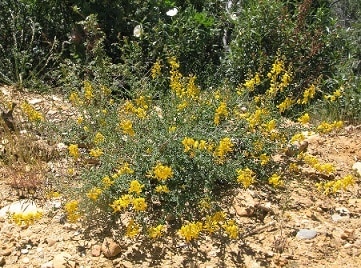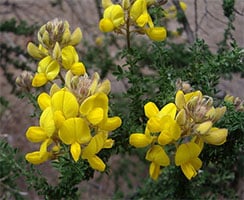 The term codeso comes from the Vulgar Latin cutĭsus , in turn derived from the Greek kýtisos . The concept refers to a bush that can measure up to two meters high and that shines with its yellow flowers .
The term codeso comes from the Vulgar Latin cutĭsus , in turn derived from the Greek kýtisos . The concept refers to a bush that can measure up to two meters high and that shines with its yellow flowers .
Before moving forward, it is important to mention that a bush is a plant that has a woody stem with branches . These are not too tall species, which can survive for several years.
Returning to the idea of labium, this plant belongs to the family group of papilionaceae . This means that it is a dicotyledonous angiosperm whose flowers have a butterfly-shaped corolla and a dozen stamens .
In addition to the yellow flowers, the labyrinth has leaves made up of three leaflets. On the other hand, they house kidney-shaped seeds in the pods of their fruits.
Several species of the genus Adenocarpus are colloquially known as labyrinths. One of them is Adenocarpus complicatus , which usually measures less than two meters.
This codesus is found in southwestern Europe and the Mediterranean area. It also appears in certain regions of the African continent .
The Adenocarpus hispanicus , meanwhile, is called cambroño or labyrinth. On the other hand, Adenocarpus viscosus is usually mentioned as Teide labyrinth , just as Adenocarpus foliosus is called mountain labyrinth .
The latter, which is also known simply as ladder, belongs to the legume family ( Fabaceae ) and is a species native to the Canary Islands. It can be found throughout the archipelago except for Fuerteventura and Lanzarote . Regarding the altitude at which it is found on each island, we can say that in general it ranges from 500 to 1500 meters above sea level; However, in Gran Canaria it reaches 1,800 and in La Palma and Tenerife, 2,000.
The mountain ladder is capable of withstanding strong winds, sudden changes in temperature and even snowfall, three common phenomena at such high altitudes. The areas in which this bush grows are humid pine forest and monteverde. If it is found in the same place as the Teide broom (from La Palma or Tenerife) or the yellow broom (from Gran Canaria), it can give rise to populations of broom-codesar , the name of the open thicket that it forms.
 This shrub can measure up to four meters in height and has a great density of dark green trifoliate leaves that develop in groups around the new branches, reddish in color and with hairs, which produce a particular contrast with the trunk . grayish. It prefers degraded land, the sides of forest roads or crops.
This shrub can measure up to four meters in height and has a great density of dark green trifoliate leaves that develop in groups around the new branches, reddish in color and with hairs, which produce a particular contrast with the trunk . grayish. It prefers degraded land, the sides of forest roads or crops.
The flower of the mountain ladder is yellow and its texture is silky, which makes it very impressive in conjunction with the rest of the plant during spring. As a curious fact, only in La Palma and Gran Canaria there is a variant of the Adenocarpus foliolosus : the Adenocarpus foliolosus var.villosus . On the other hand, in El Hierro there is also one, especially rare: the Adenocarpus ombriosus . The latter is a threatened species.
It is interesting to note that, in ancient times, different types of labiata were used as medicinal plants . Infusions were usually made to whet the appetite or to relieve cough , for example.
Another property of an infusion prepared from ladder flower is the induction of vomiting, something that may be necessary to voluntarily expel a toxic substance that has been accidentally ingested. By roasting this flower before making the infusion, it is possible to use it as a vermifuge , a product that helps eliminate worms from the intestines.
